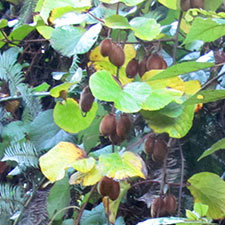 Wild kiwifruit
Wild kiwifruit
Common name: Kiwifruit
Botanical name: Actinidia spp
Management category: Progressive Containment
Kiwifruit is native to South China and is thought to have been brought to New Zealand as a fruit bearing plant as early 1900’s. Now grown commercially and exported to over 55 countries worldwide, wild kiwifruit is an unfortunate by-product.
Why is it a pest?
- Tolerant of a reasonably wide temperature range and are also very long lived.
- Grows rapidly so they compete native seedlings and pine seedlings to form dense, heavy blankets of growth.
- The smothered plants beneath the kiwifruit vines are shaded and may break under the weight of the vines.
Where is it found?
- Can grow in a wide variety of habitats including scrub, gullies, native bush and pine plantations.
- Seed is spread by birds, especially waxeyes, eating the fruit left on vines in orchards. It is also spread by humans dropping fruit remains.
- Potential spread from reject fruit being transported and dumped for use as stockfood.
What does it look like?
- Vigorous, densely hairy vine that can grow up to 20m high into the forest canopy.
- Shoots have shaggy, reddish, simplehairs when young.
- Produces white flowers (Oct- Dec) that are up to about 6 cm across.
- They are followed by edible fruits that are brown, hairy and oval with green flesh and numerous black seeds.
What are the rules?
Progressive containment
Progressive containment species are pests which the council aims to prevent from spreading, reduce the distribution, or eradicate within parts of the region over time. Landowners or occupiers are responsible for the control of progressive containment species on their property. Council may enforce the control of these pest species.
How do you get rid of it?
Council and the Kiwifruit Vine Health (KVH) are working collaboratively to maintain control and management of wild kiwifruit via a subsidised control programme.
- Cut larger plants at ground level and stump paint (November to May) with herbicide.
- Spray (November to May) with herbicide.
Follow up initial control regularly to remove seedlings.
CAUTION: When using any herbicide or pesticide, PLEASE READ THE LABEL THOROUGHLY to ensure that all instructions and directions for the purchase, use and storage of the product, are followed and adhered to.
Read more on pest control advice, information and regulations.
Images



